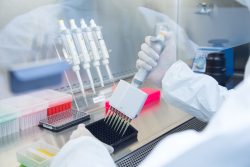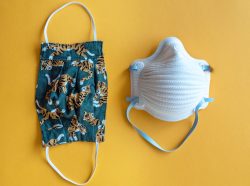Loss of Taste and Smell Linked to Higher Chance of Covid-19
 Both the loss of taste and smell have been anecdotally linked to a higher chance of developing the COVID-19 virus. The recent study has shown people are more than 10 times more likely to develop the virus infection than any other causes of infection.
Both the loss of taste and smell have been anecdotally linked to a higher chance of developing the COVID-19 virus. The recent study has shown people are more than 10 times more likely to develop the virus infection than any other causes of infection.
Researchers at UC San Diego Health have reported that the first empirical findings strongly associate sensory loss with COVID-19. The team surveyed 1,480 patients who had flu-like symptoms and concerns regarding the potential of infection. Contained in that total, 102 patients tested positive for the virus and 1,378 tested negative. The study included responses from 203 COVID-19 negative patients and 59 positive patients.
68% of the positive participants reported loss of smell and 71% reported loss of taste as compared with 16% and 17% of negative patients respectively. None of the participants in the study required hospitalization or invasive breathing support. However, if social distancing was not in place, these individuals could possibly spread the infection to others within their community despite not experiencing severe symptoms.
The study has demonstrated the unique presentation and high prevalence of certain sensory impairments in patients who were positive with the virus. Of those patients who reported loss of taste and smell the loss typically profound and not mild. However, encouragingly the rate of recovery of taste and smell was high and typically occurred within two to four weeks after infection.
The study not only showed that the high occurrence of taste and smell loss is specific to the COVID-19 virus, but also fortunately has shown that the majority of people experienced sensory recovery fairly rapidly. Within the COVID-19 patients with loss of smell, more than 70% reported improvement in smell at the time of the survey. Most of those who hadn’t reported improvement had only been diagnosed recently.
The return of taste and smell typically matched the timing of recovery from the disease. Interestingly, the researchers found that people who reported experiencing a sore throat more often tested negative for the virus.
To help decrease the risk of virus transmission, UC San Diego Health now includes loss of taste and smell as a screening requirement for staff and visitors. The screening is also a marker for testing patients who might be positive for the virus.
Other symptoms of COVID-19 include fatigue, fever, difficulty breathing, and cough. Respondents in the study were most often people with milder forms of COVID-19 infection who did not require hospitalization or intubation. The team’s findings stress the importance of identifying subtle and early symptoms of the virus in people who might be at risk of transmitting the disease as they recuperate within their community.
The CDC has officially listed loss of taste and smell as symptoms of the virus which is a validation of the ruminating concerns about these symptoms around the world. It is the hope that the team’s findings inspire other institutions to follow suit and not only list taste and smell loss as a symptom of the virus, but also use it as a screening measure for the virus around the world.
To view the original scientific study click below



 New research has found that quite the opposite is true. Previously a growing body of research has suggested that a poor quality of sleep is linked to an increased risk of obesity through deregulating appetite which results in higher caloric consumption. However, the latest study actually shows a flip side to that suggesting obesity leads to poor sleep. It isn’t the loss of sleep that leads to obesity, but instead it is excess weight that can lead to poor sleep.
New research has found that quite the opposite is true. Previously a growing body of research has suggested that a poor quality of sleep is linked to an increased risk of obesity through deregulating appetite which results in higher caloric consumption. However, the latest study actually shows a flip side to that suggesting obesity leads to poor sleep. It isn’t the loss of sleep that leads to obesity, but instead it is excess weight that can lead to poor sleep.  With the world in the middle of the COVID-19 pandemic, public health policies that could decrease the danger of infection and even death along with less quarantines are greatly needed. Vitamin D supplementation shows promise in reducing those risks in both the COVID-19 virus and influenza.
With the world in the middle of the COVID-19 pandemic, public health policies that could decrease the danger of infection and even death along with less quarantines are greatly needed. Vitamin D supplementation shows promise in reducing those risks in both the COVID-19 virus and influenza. According to a new study by researchers at Stanford University of Medicine, old human cells will return to a more vigorous and youthful state following being induced to briefly express a protein panel involved in embryonic development. They team also discovered that elderly mice regained their youthful strength after their existing muscle stem cells were subjected to the protein treatment rejuvenation and then transplanted back into their bodies.
According to a new study by researchers at Stanford University of Medicine, old human cells will return to a more vigorous and youthful state following being induced to briefly express a protein panel involved in embryonic development. They team also discovered that elderly mice regained their youthful strength after their existing muscle stem cells were subjected to the protein treatment rejuvenation and then transplanted back into their bodies. During the beginning of the COVID-19 Pandemic CDC recommends people wear face masks when in public. Due to the shortage of N95 and surgical masks, they have recommended people make their own coverings. Some materials can filter out particles much better than others, significantly affecting how well a homemade face mask may protect a person from the virus.
During the beginning of the COVID-19 Pandemic CDC recommends people wear face masks when in public. Due to the shortage of N95 and surgical masks, they have recommended people make their own coverings. Some materials can filter out particles much better than others, significantly affecting how well a homemade face mask may protect a person from the virus. A current study under leadership at the University Hospital Bonn, has concluded that a diet high in salt not only is not good for blood pressure, but also for a persons immune system. Mice who were fed a diet high in salt suffered from more serious bacterial infections. Human participants who also consumed high levels of salt also showed higher immune deficiencies.
A current study under leadership at the University Hospital Bonn, has concluded that a diet high in salt not only is not good for blood pressure, but also for a persons immune system. Mice who were fed a diet high in salt suffered from more serious bacterial infections. Human participants who also consumed high levels of salt also showed higher immune deficiencies.  Surgical masks and N95 respirators are examples of personal protective equipment (PPE) which are used to protect the wearer from liquid contamination and airborne particles from contaminating the face. It is important to know the optimal way to prevent airborne transmission. Each type of mask and also cloth face masks serve different functions.
Surgical masks and N95 respirators are examples of personal protective equipment (PPE) which are used to protect the wearer from liquid contamination and airborne particles from contaminating the face. It is important to know the optimal way to prevent airborne transmission. Each type of mask and also cloth face masks serve different functions.  A recent study by a team at the University of Leeds, UK was set up to determine if the use of paper towels or air dryers is more effective for getting rid of microbes when the hands are still drying and contanminated.
A recent study by a team at the University of Leeds, UK was set up to determine if the use of paper towels or air dryers is more effective for getting rid of microbes when the hands are still drying and contanminated. A top exercise researcher has reported that regular exercise may reduce the risk of acute respiratory distress syndrome (ARDS) which is a major cause of death in people with the COVID-19 virus. He is now urging people to exercise regularly as a way of possibly preventing or at least reducing the severity of ARDS.
A top exercise researcher has reported that regular exercise may reduce the risk of acute respiratory distress syndrome (ARDS) which is a major cause of death in people with the COVID-19 virus. He is now urging people to exercise regularly as a way of possibly preventing or at least reducing the severity of ARDS. The largest hospital system in New York is now giving high doses of Vitamin C intravenously for patients with COVID 19. The treatment is based on Chinese reports of this approach helping patients with the virus.
The largest hospital system in New York is now giving high doses of Vitamin C intravenously for patients with COVID 19. The treatment is based on Chinese reports of this approach helping patients with the virus.